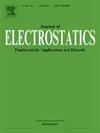Numerical simulation and experimental study of the negative corona charging process on a wire-to-wire electrode in a steam jet
IF 2.1
4区 工程技术
Q3 ENGINEERING, ELECTRICAL & ELECTRONIC
引用次数: 0
Abstract
This study investigated the influence of wire-to-wire electrode structures and steam conditions on corona discharge behavior and the charging characteristics of steam jets. The corona discharge current, charge-to-mass ratio of the steam jet, and droplet size distribution near the electrode were measured. The temperature and velocity distributions along the central axis of the steam jet were determined using empirical formulas. A joint model of corona unipolar particles and field-induced charging along the jet axis was developed and the numerical results closely matched experimental data. The findings revealed that variations in water vapor content around the corona electrode significantly affected corona currents. Specifically, higher water vapor mass fractions resulted in reduced corona discharge currents. Particle size measurements indicated that steam jets with higher Reynolds numbers generated smaller droplets in greater quantities. Larger droplets moving in the steam jet accumulated higher charges, but the charge-to-mass ratio decreases with increasing droplet size. Notably, the distribution of droplet sizes was a critical factor influencing the charging characteristics of steam jets. A steam jet with a higher Reynolds number achieved a charge-to-mass ratio of up to 2.17 mC/kg, demonstrating its enhanced charging capacity.
蒸汽射流中线对线电极负电晕充电过程的数值模拟与实验研究
研究了线对线电极结构和蒸汽条件对蒸汽射流电晕放电行为和充电特性的影响。测量了电晕放电电流、蒸汽射流的电荷质量比和电极附近液滴的尺寸分布。利用经验公式确定了蒸汽射流沿中轴线的温度和速度分布。建立了沿射流轴方向的电晕单极粒子和场致电荷联合模型,数值结果与实验数据吻合较好。研究结果表明,电晕电极周围水蒸气含量的变化显著影响电晕电流。具体来说,较高的水蒸气质量分数导致电晕放电电流降低。颗粒尺寸测量表明,高雷诺数的蒸汽射流产生的液滴体积更小,数量更多。在蒸汽射流中运动的液滴越大,电荷积累越多,但电荷质量比随液滴尺寸的增大而减小。值得注意的是,液滴尺寸分布是影响蒸汽射流充装特性的关键因素。高雷诺数蒸汽射流的电荷质量比达到2.17 mC/kg,证明了其增强的充电能力。
本文章由计算机程序翻译,如有差异,请以英文原文为准。
求助全文
约1分钟内获得全文
求助全文
来源期刊

Journal of Electrostatics
工程技术-工程:电子与电气
CiteScore
4.00
自引率
11.10%
发文量
81
审稿时长
49 days
期刊介绍:
The Journal of Electrostatics is the leading forum for publishing research findings that advance knowledge in the field of electrostatics. We invite submissions in the following areas:
Electrostatic charge separation processes.
Electrostatic manipulation of particles, droplets, and biological cells.
Electrostatically driven or controlled fluid flow.
Electrostatics in the gas phase.
 求助内容:
求助内容: 应助结果提醒方式:
应助结果提醒方式:


